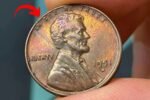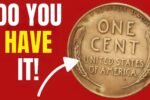It’s not every day that an ordinary pocketful of change turns into a small fortune. But for those who take a second look at the coins jingling in their pockets, the surprise might be worth hundreds—or even thousands—of dollars. One particular coin, the 2004 Wisconsin State Quarter, has recently captivated the attention of numismatists and casual collectors alike. This seemingly unremarkable 25-cent piece has become one of the most wanted coins in America thanks to an unexpected minting anomaly. If you’ve ever dismissed the coins at the bottom of your drawer, you may want to reconsider. Because hiding among them could be a Wisconsin State Quarter that’s worth far more than its face value.
Rare 1909-S VDB Lincoln Penny Found Behind Wall Clock Could Fetch Over $85,000
The 2004 Wisconsin State Quarter: Why It’s Making Headlines
The Wisconsin State Quarter, part of the U.S. Mint’s ambitious and wildly popular 50 State Quarters Program, was released in 2004 to honor the state of Wisconsin and its agricultural roots. The coin’s reverse design showcases a proud Holstein cow, a large wheel of cheese, and an ear of corn—symbols of the state’s dairy and farming heritage. At first glance, it looks like any other quarter. However, a small number of these coins left the mint with a highly unusual feature that has collectors in a frenzy: an extra leaf on the ear of corn.
This error doesn’t exist on most quarters. In fact, there are two known variations of the mistake—one with an extra leaf that points downward and another with one that juts upward. These varieties are now famously known as the “extra leaf low” and “extra leaf high” Wisconsin State Quarters. What makes them so captivating is how this flaw likely occurred: a die gouge during production, creating an unintended imprint that made the coin unique.
A Minting Mistake That Turned Into Gold
What elevates the Wisconsin State Quarter to collector fame is not just the error itself, but how rare and visually distinct it is. In most cases, mint errors are subtle—sometimes even invisible to the naked eye. But with this quarter, the extra leaf is clearly visible on close inspection, making it a standout example of a die error that’s easy to authenticate. And with error coins, visibility often equals value.
Depending on the coin’s condition, its type of error (high or low leaf), and whether it has been professionally graded, the value can range dramatically. A circulated version may sell for a few hundred dollars, while an uncirculated or near-mint condition Wisconsin State Quarter can fetch up to $1,500 or more at auction. In some cases, prices have even crept beyond that range, especially when bidding wars break out among serious collectors.
The Legacy of the 50 State Quarters Program
To fully understand why this particular quarter has captured the imagination of collectors, it helps to take a step back and consider the legacy of the 50 State Quarters Program. Launched in 1999, the initiative was designed to commemorate each U.S. state with its own distinctive quarter, rolled out in the order in which the states joined the Union. Spanning a full decade and ending in 2008, the program reinvigorated public interest in coin collecting, with an estimated 140 million Americans participating—many of them for the first time.
Each coin had a limited run, and while most are still common in circulation today, certain state quarters have gained extra attention due to mintage anomalies, low production volumes, or errors like the one found on the Wisconsin State Quarter. Though millions of standard Wisconsin quarters were produced, the extra leaf errors are believed to exist in only a small subset of those, particularly those minted in Denver. That rarity has helped propel the coin to the upper tier of modern collectible currency.
From Pocket Change to Investment Asset
What makes the Wisconsin State Quarter story especially compelling is how it transforms the narrative around coins we use every day. It blurs the line between ordinary currency and investment asset. For those who think valuable coins are confined to dusty old collections or historical relics, the rise of this modern quarter is a wake-up call.
It’s not unusual to hear stories of individuals discovering an extra leaf Wisconsin State Quarter in their spare change or coin jars—completely unaware of its potential value. And unlike some collectibles that are hard to verify or easy to counterfeit, the extra leaf variation is a concrete, identifiable anomaly that gives this coin both authenticity and demand.
Professional grading agencies like PCGS (Professional Coin Grading Service) and NGC (Numismatic Guaranty Corporation) have verified and certified hundreds of these quarters, lending further legitimacy to their value in the market. Coins that have received high grades—especially MS-65 and above—are particularly lucrative for sellers.
Renewed Interest in Coin Collecting
The buzz surrounding the Wisconsin State Quarter has reignited a sense of discovery and curiosity among new and seasoned collectors alike. Coin forums and social media groups have exploded with images of quarters as enthusiasts check their change in hopes of finding one of the coveted variants. The story serves as a powerful reminder that sometimes, history and value can lie hidden in the most mundane places.
For many, the discovery of such a coin can be life-changing. Imagine realizing that a quarter sitting in your car’s cup holder or tucked away in an old wallet could be worth hundreds or even thousands of dollars. It’s not just about the money, either. For collectors, the thrill of finding something rare and significant offers its own kind of reward—one that ties together history, craftsmanship, and the enduring charm of numismatics.
How to Spot an Error Wisconsin Quarter
If you want to check whether you’ve got a valuable Wisconsin State Quarter, start by flipping the coin over and looking closely at the ear of corn. On a normal coin, the corn has a single leaf along its side. But on the error coins, there’s an additional leaf—either slightly above or below the main one.
You don’t need fancy equipment to identify it. A magnifying glass or a high-quality photo from your smartphone may be enough. If you suspect you’ve found one, don’t clean or alter it. Cleaning a coin can severely decrease its value. Instead, consult with a reputable coin dealer or submit it to a grading service to have it evaluated professionally.
What to Do If You Find One
The first rule of finding any potentially valuable coin is: don’t panic and don’t clean it. Many people unintentionally damage rare coins by trying to polish them or improve their appearance. Professional coin graders are trained to assess condition and authenticity based on original surfaces, not shininess.
Once you’ve confirmed that your quarter is indeed a high or low leaf Wisconsin State Quarter, you have several options. You could choose to keep it as a valuable addition to your collection or put it up for sale through a coin dealer, online auction platform, or a numismatic marketplace. Make sure you get a few different appraisals before agreeing to a sale price, as the value can vary depending on market demand and coin condition.
A Symbol of America’s Hidden Treasures
The story of the Wisconsin State Quarter is more than just a tale of a minting mistake—it’s a celebration of the hidden value that can lie in plain sight. It proves that even in today’s high-tech, fast-paced world, a simple coin can still capture the imagination of millions. From coin shows to kitchen countertops, collectors across the country are keeping a close eye on their quarters, hoping to strike gold—figuratively speaking—with one of these elusive error coins.
The beauty of collecting lies in its unpredictability. And the Wisconsin State Quarter serves as a shining example of how a small piece of metal, marked by an imperfection, can become a national treasure.
FAQ – Wisconsin State Quarter
1. Why is this quarter so valuable?
Some 2004 Wisconsin quarters have a minting error—an extra leaf on the corn—which makes them rare and highly sought after.
2. How can I identify the error?
Look at the corn on the reverse side of the coin. If you notice an additional leaf pointing either up or down, it’s an error coin.
3. What should I do if I find one?
Avoid cleaning the coin. Instead, get it appraised or graded by a professional numismatist or reputable coin grading service.
Some Important Link
| Telegram Group | Click Here |
| WhatsApp Group | Click Here |
| Home Page | Click Here |














